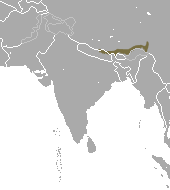Himalayan Pika
| Himalayan Pika | ||||||||||||
|---|---|---|---|---|---|---|---|---|---|---|---|---|

Himalayan Pika ( Ochotona himalayana ) |
||||||||||||
| Systematics | ||||||||||||
|
||||||||||||
| Scientific name | ||||||||||||
| Ochotona himalayana | ||||||||||||
| Feng , 1973 |
The Himalayan Pfeifhase ( Ochotona himalayana ) is a species of mammal from the family of the Pfeifhasen within the hare-like . Their distribution area is limited to the northern edge of the Himalayas in the Chinese province of Xizang (Tibet Autonomous Region).
features
The Himalayan pika is a relatively large pika. It reaches a body length of 14.0 to 18.6 centimeters. He has a dull gray back fur and is characterized by a reddish brown to brown color on the head and shoulders. Important features for differentiating it from the Royle-Pfeifhasen ( Ochotona roylei ) concern the skull morphology, especially the lack of skull windows in the frontal bone .
distribution
The distribution area of the Himalayan Pika runs along the northern border of the Himalayas in the Chinese province of Xizang (Tibet Autonomous Region). It is unclear whether the species also occurs in Nepal .
The Himalayan Pika lives on the edges of coniferous forests on scree slopes, in rock faces and on steep slopes of the Himalayas at altitudes between 2,400 and 4,200 meters.
Way of life
Very little information is available about the way of life of this pika. Its main activity is in the morning and at dusk. It feeds on plants in a generalist way. The litters consist of three to four young animals.
Systematics
The Himalayan Pfeifhase was assigned to the Pfeifhasen (genus Ochotona ) as an independent species , the species status was confirmed by molecular biological studies. Originally, it was placed as a subspecies of Royle-Pfeifhase ( Ochotona roylei ), but AA Lissovsky does not consider it in the Handbook of the Mammals of the World as an independent subspecies and describes it as a synonym of Royle-Pfeifhase.
Hazard and protection
The species is classified by the International Union for Conservation of Nature and Natural Resources (IUCN) as least concern due to its large distribution area and the lack of a known threat. However, no data is available on the size of the stock or on the stock trend.
supporting documents
- ↑ a b c Joseph A. Chapman, John EC Flux (Ed.): Rabbits, Hares and Pikas. Status Survey and Conservation Action Plan. (PDF; 11.3 MB) International Union for Conservation of Nature and Natural Resources (IUCN), Gland 1990; Pp. 33-34. ISBN 2-8317-0019-1 .
- ↑ a b c d e f Ochotona himalayana in the endangered species Red List of IUCN 2011. Submitted By: AT Smith, CH Johnston, 2008. Retrieved on 21 February 2012 found.
- ^ AA Lissovsky: Forrest's Pika - Ochotona forresti. In: Don E. Wilson, TE Lacher, Jr., Russell A. Mittermeier (editors): Handbook of the Mammals of the World: Lagomorphs and Rodents 1. (HMW, Volume 6), Lynx Edicions, Barcelona 2016; 58. ISBN 978-84-941892-3-4
literature
- Joseph A. Chapman, John EC Flux (Eds.): Rabbits, Hares and Pikas. Status Survey and Conservation Action Plan. (PDF; 11.3 MB) International Union for Conservation of Nature and Natural Resources (IUCN), Gland 1990; Pp. 33-34. ISBN 2-8317-0019-1 .
Web links
- Ochotona himalayana in the endangered Red List species the IUCN 2011. Posted by: AT Smith , CH Johnston, 2008. Accessed February 21 2012th
